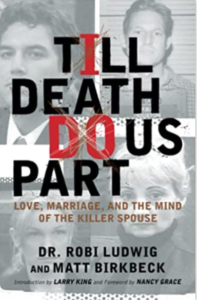“Till death do us part” can be taken literally all too often.

If a new episode of Dateline begins, and you shout, “The husband did it!” before the opening credits have even finished, you’re not alone. Blaming bad husbands and shady boyfriends is nothing new in the true crime world — but is the blame warranted?
Unfortunately, there’s something to be said about the accuracy of the phrase.
Every day, six people are killed in America by their spouse or intimate partner. Globally, a total of 50,000 women are murdered annually by the person they’re supposed to love and trust.
It’s nearly always female victims murdered by their husbands or male partners.
 This phenomenon and subsequent discussion have spread through the internet like wildfire following the mysterious New Year’s Day disappearance of Massachusetts mother Ana Walshe.
This phenomenon and subsequent discussion have spread through the internet like wildfire following the mysterious New Year’s Day disappearance of Massachusetts mother Ana Walshe.
Ana, 39, was first reported missing on January 4th, days after she failed to show up to her job as a real estate executive in Washington D.C., where she would regularly commute.
Law enforcement officials immediately began to zero in on Ana’s husband, Brian Walshe. It is no surprise that Brian was arrested and charged with Ana’s murder on January 17th following a mountain — no, an avalanche — of circumstantial evidence pointing to something sinister.
“How to dispose of a 115-pound woman’s body”
Police have yet to figure out how Ana went missing, but they discovered some damning pieces of evidence that will need an expert team of defense attorneys to tackle.
Detectives searched the Walshe family home and found blood in the basement and a bloodstained, damaged knife. They also discovered a hacksaw, a hatchet with traces of more blood, and used cleaning supplies. A little more than an hour from home, a rug with “biological evidence” was found at a trash transfer station.
 Even more damning, Brian allegedly searched for “how to dispose of a 115-pound woman’s body” and “dismemberment,” prosecutors told the public.
Even more damning, Brian allegedly searched for “how to dispose of a 115-pound woman’s body” and “dismemberment,” prosecutors told the public.
When the police spoke with Brian, they knew his alibi didn’t add up.
Prosecutors also shared that on January 2nd, after Ana was last seen, Brian was captured on Home Depot surveillance footage spending $450 on cleaning products, including mops and tarps. However, Brian already told authorities he was 40 miles away visiting a Whole Foods and CVS during that time.
Neither establishment could corroborate his story.
Brian already faced a charge of misleading police during the investigation into Ana’s whereabouts. He has not yet been arraigned on the murder charge. The couple’s children, ages 2, 4, and 6, are in the Massachusetts Department of Children and Families custody.
Authorities are still scouring the trash transfer station in Peabody for her potential remains, considering Ana’s tragic case highlights gut-wrenching homicide statistics.
Homicide is one of the leading causes of death for women aged 44 years and younger.
When women are killed, they are more likely to be murdered by an intimate male partner. But, when men are killed, they are more likely to be murdered by a male stranger or a non-family acquaintance.
A recent report from the Centers for Disease Control and Prevention analyzed the murders of women in 18 states from 2003 to 2014, finding a total of 10,018 deaths. Of those, the perpetrator in 55 percent of those cases was an intimate partner.
Why do Men Kill their Wives?
The CDC report notes that in about a third of cases where a man kills their wife, the couple argued right before the homicide. The most common motive was jealousy, and 15 percent of the women were pregnant.
Like other homicides, jealousy isn’t the only possible motive present when a person kills their spouse.
 Dr. Robi Ludwig, the co-author of “Til Death Do Us Part” and a psychotherapist, says spousal killers are complex and notes ten profiles in her book.
Dr. Robi Ludwig, the co-author of “Til Death Do Us Part” and a psychotherapist, says spousal killers are complex and notes ten profiles in her book.
In speaking with ABC News, Ludwig gives a few examples, noting the “Temper Tantrum Killer” is someone prone to violent outbursts when their needs are unmet and resorts to killing their partner after enough triggers have been flamed.
She said Scott Peterson, who was convicted of killing his pregnant wife, Laci, and sentenced to death, falls into this category.
There’s also the “Narcissistic Killer,” who harms another person who no longer fulfills the offender’s needs. Ludwig cited Rabbi Fred Neulander, who was convicted of having his wife killed so he could continue an affair.
Most domestic homicides are committed with firearms, and interestingly, 66% of homicidal husbands were either drinking alcohol or were under the influence of drugs.
Wives who Kill their Husbands
When women take another person’s life, they kill their spouse or an intimate partner 60% of the time. To that end, women turning to murder is exceedingly rare. The National Crime Victimization Surveys estimate that intimate partner homicides perpetrated by wives account for just 4% of murders of men.
Nearly all women offenders used weapons — 95% of wives used a gun or a knife.
In stark contrast to the motivations that lead husbands to kill their wives, in 44% of wife defendant cases, there was evidence that the wife had acted in self-defense against a violent attack from her husband at the time of the killing.
In other words, when wives kill their husbands, sometimes they’re protecting themseleves from harm.
This would also explain why wife defendants have a lower conviction rate than husbands on trial.
To that end, wives who kill didn’t get the moniker Black Widow Killers for nothing. Some married female offenders can be as cold-blooded as their male counterparts.
Now, when a new episode of Dateline begins and you blurt out that you’re skeptical of the husband’s alibi, you’ll know data and real examples to back up your suspicions.
